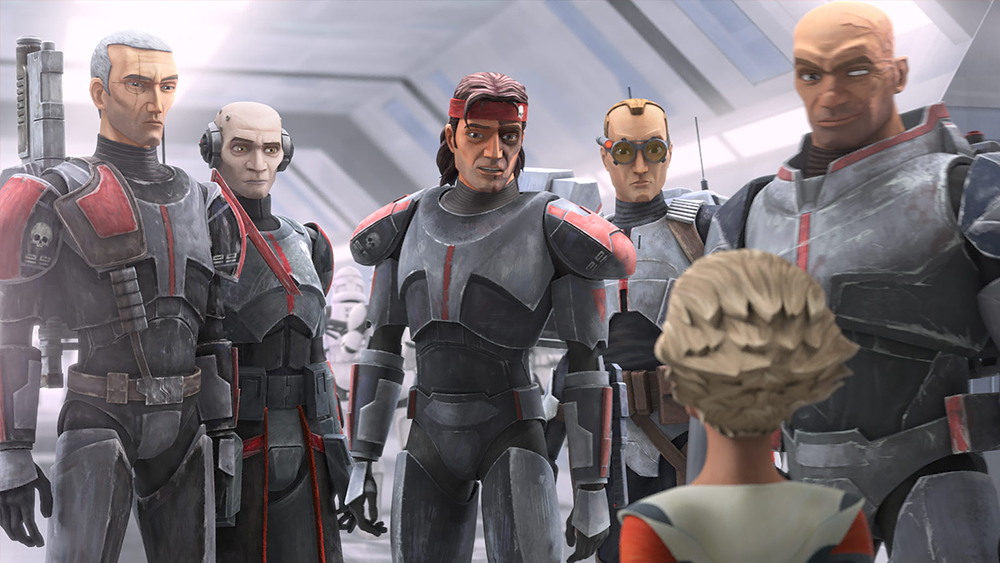The Star Wars prequels have been getting something of a re-evaluation lately. Maybe it’s a case of first-wave Millennial nostalgia, as the grown-up children of the ’90s reconnect with the media they remember, like the Boomers watching Happy Days. There is certainly that element, but I think the prequels are aging well because George Lucas’ overarching story of the fall of the Old Republic looks increasingly prescient.
The latest Disney+ animated series, Star Wars: The Bad Batch, begins as the prequel trilogy is reaching its climax. Like its live-action cousin The Mandalorian, The Bad Batch spins stories outside of the suffocating shadow of the Skywalker family melodrama. World-building has always been the franchise’s strong suit, so there are plenty of implied side stories in the galaxy far, far away to mine for material.
To me, one of the most profound questions the universe poses is raised in one of its filmic low points. Attack of the Clones is emblematic of the prequels, in both its strengths and weaknesses. The visuals are ahead of their time — no one else in the special effects game could touch turn-of-the-century Industrial Light & Magic, and Lucas retained his sharp eye for design until he retired. But he also seemingly forgot how to delegate, and he badly needed a writer. But success is an insidious poison, and so we got one of the worst on-screen romances ever, and a jumbled presentation of what is actually a compelling story of politics and manipulation. In the early days of the War on Terror, the story was a reminder of the dangers of an out-of-control security state.

Senator Palpatine, who is secretly the evil space wizard Darth Sidious, engineers a separatist threat to the Galactic Republic and uses the crisis to have himself declared chancellor, and as an excuse to build an army of clones. As the Clone Wars grind on, Palpatine grooms his vainglorious apprentice Anakin Skywalker into Darth Vader, then orders his clone armies to ambush and kill their Jedi commanders.
That moment — known as “Order 66” — is the heart-rending climax of Revenge of the Sith; Obi Wan and Anakin’s fateful lightsaber duel pales in comparison. The clones, bred for the sole purpose of combat and forced by implanted chips to betray their comrades, become tragic figures in The Clone Wars animated series, which was finally given the ending it deserved by Disney+ last year. The Bad Batch is a group of elite clone commandos introduced in the final season. They are defective units rescued from disposal by Kamino’s clone master Nala Se (Gwendoline Yeo) for experimental upgrades. Their names are their purpose: Hunter, Wrecker, Tech, Crosshair, and Echo are all voiced by Dee Bradley Baker. The Bad Batch’s defects are their strengths, and when Order 66 comes in as they are backing Jedi master Depa Billaba (Archie Panjabi), they find that their controlling chips don’t work. Hunter, experiencing his first taste of free will in the midst of a galaxy-wide political upheaval, secretly lets Depa’s padawan escape.
The Order 66 sequence in the 70-minute pilot episode takes on unexpected relevance in the wake of the January 6th insurrection at the Capitol. As the assembled clones on Kamino listen to Palpatine announce the creation of the Empire, the Bad Batch realize it’s wrong but don’t quite know what to do about it. When Admiral Tarkin (Stephen Stanton, doing an uncanny Peter Cushing imitation) arrives to take command of the clones, he orders the commandos on a mission to mop up a group of separatist insurgents. When you’re a clone, nothing stops the Forever War. As they leave, a deviant female clone named Omega (Michelle Ang) begs them to take her. But the Separatists turn out to be a group of refugees from the Republic led by Saw Gerrera (Andrew Kishino), and the Bad Batch decide to desert, but not before returning to Kamino to retrieve Omega.
Led by Clone Wars and The Mandalorian writer/producer Dave Filoni, The Bad Batch expertly zeroes in on the questions of free will raised by the creation of semi-disposable, sentient clones. But more than an A.I. cautionary tale, the show’s themes could not be more relevant, such as, how much loyalty does an oppressed class owe a flawed democracy? The second episode reverts to a more conventional sci-fi escape story, but the background of a society losing its freedom and self-determination serves as a stark warning in these perilous times.
Star Wars: The Bad Batch is streaming on Disney+.
